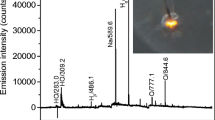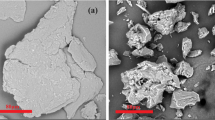Abstract
Biodegradable and ultrahigh content grafted chitosan-g-poly(acrylic acid) powder was successfully synthesized in a homogeneous system and used as adsorbents for the removal of Cu(II) in aqueous solution. The copolymer was characterized by various techniques. The fundamental adsorption behaviors of the material were studied. The adsorption isotherm was well fitted with Langmuir equation, while the adsorption kinetics preferred to be described the pseudo-second order equation. The maximum adsorption capacity obtained from the Langmuir model was 210.13 mg/g, indicating that the adsorption capacity of chitosan was enhanced remarkably after grafting poly(acrylic acid). Moreover, Fourier transform infrared spectroscopy (FT-IR) and X-ray photoelectron spectroscopy (XPS) have been used to investigate the adsorption mechanisms at molecular levels, which revealed that carboxyl groups are facile to form bidentate carboxylates with metal ions. Thus, the environment-friendly copolymer will be a promising candidate for application in removal of heavy metal ions.









Similar content being viewed by others
References
Beppu MM, Arruda EJ, Vieira RS, Santos NN (2004) Adsorption of Cu(II) on porous chitosan membranes functionalized with histidine. J Member Sci 240(1–2):227–235
Wan Ngah WS, Teong LC, Hanafiah MAKM (2011) Adsorption of dyes and heavy metal ions by chitosan composites: a review. Carbohydr Polym 83(4):1446–1456
Zhang L, Zeng Y, Cheng Z (2016) Removal of heavy metal ions using chitosan and modified chitosan: a review. J Mol Liq 214:175–191
Pal A, Das D, Sarkar AK, Ghorai S, Das R, Pal S (2015) Synthesis of glycogen and poly (acrylic acid)-based graft copolymers via ATRP and its application for selective removal of Pb2+ ions from aqueous solution. Eur Polym J 66:33–46
Ren H, Gao Z, Wu D, Jiang J, Sun Y, Luo C (2016) Efficient Pb(II) removal using sodium alginate–carboxymethylcellulose gel beads: preparation, characterization, and adsorption mechanism. Carbohydr Polym 137:402–409
Jiang TD (2007) Chitosan. Chemical Industry Press, Beijing
Peng S, Meng H, Ouyang Y, Chang J (2014) Nanoporous magnetic cellulose−chitosan composite microspheres: preparation, characterization, and application for Cu(II) adsorption. Ind Eng Chem Res 53(6):2106–2113
Dai J, Han Y, Yang H, Cheng R (2010) Simple method for preparation of chitosan/poly(acrylic acid) blending hydrogelbeads and adsorption of copper(II) from aqueous solutions. Chem Eng J 165(1):240–249
Song Q, Wang C, Zhang Z, Gao J (2014) Adsorption of Cu(II) and Ni(II) using a novel xanthated carboxymethyl chitosan. Separ Sci Technol 49(8):1235–1243
Wang X, Zheng Y, Wang A (2009) Fast removal of copper ions from aqueous solution by chitosan-g-poly(acrylic acid)/attapulgite composites. J Hazard Mater 168(2–3):970–977
Huang M, Jin X, Li Y, Fang Y (2006) Syntheses and characterization of novel pH-sensitive graft copolymers of maleoylchitosan and poly(acrylic acid). React Funct Polym 66(10):1041–1046
Zheng Y, Huang D, Wang A (2011) Chitosan-g-poly(acrylic acid) hydrogel with crosslinked polymeric networks for Ni2+ recovery. Anal Chim Acta 687:193–200
Ren Y, Li N, Feng J, Luan T, Wen Q, Li Z, Zhang M (2012) Adsorption of Pb(II) and Cu(II) from aqueous solution on magnetic porous ferrospinel MnFe2O4. J Colloid Interface Sci 367(1):415–421
Kyzass GZ, Siafaka PI, Lambropoulou DA, Lazaridis NK, Bikiaris DN (2014) Poly(itaconic acid)-grafted chitosan adsorbents with different cross-linking for Pb(II) and Cd(II) uptake. Langmuir 30(1):120–131
Al-Karawi AJM, Al-Qaisi ZHJ, Abdullah HI, Al-Heetimi DTA (2011) Synthesis, characterization of acrylamide grafted chitosan and its use in removal of copper(II) ions from water. Carbohydr Polym 83(2):495–500
Chen Y, Tan H (2006) Crosslinked carboxymethylchitosan-g-poly(acrylic acid) copolymer as a novel superabsorbent polymer. Carbohydr Res 341(7):887–896
El-Khaiary MI, Malash GF (2011) Common data analysis error in batch adsorption studies. Hydrometallurgy 105(3–4):314–320
Yan H, Dai J, Yang Z, Yang H, Cheng R (2011) Enhanced and selective adsorption of copper(II) ions on surface carboxymethylated chitosan hydrogel beads. Chem Eng J 174(2–3):586–594
Zhang S, Zhou Y, Nie W, Song L, Zhang T (2012) Preparation of uniform magnetic chitosan microcapsules and their application in adsorbing copper ion(II) and chromium ion(III). Ind Eng Chem Res 51(43):14099–14106
Yan H, Yang L, Yang Z, Yang H, Li A, Cheng R (2012) Preparation of chitosan/poly(acrylic acid) magnetic composite microspheres and applications in the removal of copper(II) ions from aqueous solutions. J Hazard Mater 229-230:371–380
Xu J, Xu X, Zhao H, Luo G (2013) Microfluidic preparation of chitosan microspheres with enhanced adsorption performance of copper(II). Sensor Actuat B-Chem 183:201–210
Ong S-T, Tay EH, Ha S-T, Lee W-N, Keng P-S (2009) Equilibrium and continuous flow studies on the sorption of Congo Red using ethylenediamine modified rice hulls. Int J Phys Sci 4(11):683–690
Liu X, Zhang L (2015) Removal of phosphate anions using the modified chitosan bead: adsorption kinetic, isotherm and mechanism studies. Powder Technol 277:112–119
Malash GF, El-Khaiary MI (2010) Piecewise linear regression: a statistical method for the analysis of experimental adsorption data by the intraparticle-diffusion models. Chem Eng J 163(3):256–263
Rocha LS, Lopes CB, Borges JA, Duarte AC, Pereira E (2013) Valuation of unmodified rice husk waste as an eco-friendly sorbent to remove mercury: a study using environmental realistic concentrations. Water Air Soil Poll 224(7):1599
Deacon GB, Philips RJ (1980) Relationships between the carbon-oxygen stretching frequencies of carboxylato complexes and the type of carboxylate coordination. Coord Chem Rev 33(3):227–250
Spinner E (1967) Vibration-spectral studies of carboxylate ions. Part III. Sodium formate, HCO2Na and DCO2Na; Raman-spectral depolarisation ratios in aqueous solution, and band splitting in the solid-state infrared spectrum. J Chem Soc B 9:879–885
Dietrich PM, Hennig A, Holzweber M, Lippitz A, Unger WES (2014) Surface analytical study of poly(acrylic acid)-grafted microparticles (beads): characterization, chemical derivatization, and quantification of surface carboxyl groups. J Phys Chem C 118(35):20393–20404
Acknowledgements
This work was supported by the National Natural Science Foundation of China (51303003, 51303002) and Natural Science Foundation of Anhui (1408085QE76).
Author information
Authors and Affiliations
Corresponding author
Ethics declarations
Conflict of interest
The authors declare that they have no conflict of interest.
Rights and permissions
About this article
Cite this article
Lin, Y., Hong, Y., Song, Q. et al. Highly efficient removal of copper ions from water using poly(acrylic acid)-grafted chitosan adsorbent. Colloid Polym Sci 295, 627–635 (2017). https://doi.org/10.1007/s00396-017-4042-8
Received:
Revised:
Accepted:
Published:
Issue Date:
DOI: https://doi.org/10.1007/s00396-017-4042-8




